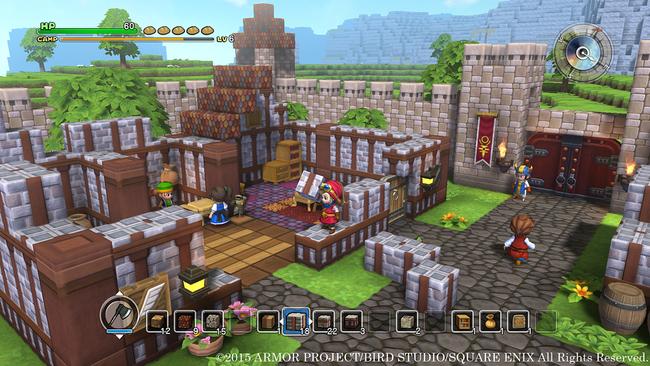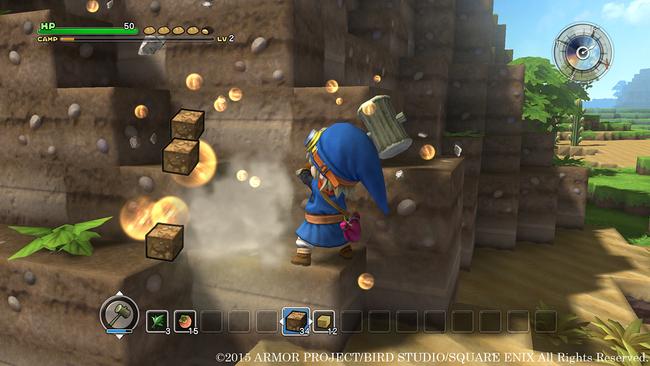
Dragon Quest Builders Review
There is a certain degree of ambition required to take a revered franchise and put it in a setting the audience is not accustomed to. Thankfully in the case of Dragon Quest Builders, it succeeds in this endeavor and does so while staying true to its roots. This is due in part to using a narrative to contextualize the world, a progression system that gives you incentive to stick with it, and a framework that appeals to players no matter their background with Dragon Quest or creation games.
Before I get going with this review proper, I should probably note that I have never played a Dragon Quest game prior to Builders. Furthermore, I have very limited experience in games of the Minecraft ilk. I may not be the prime candidate to review Dragon Quest Builders because of all this, but despite my inexperience I found myself quite enamored with the game ever since it fell into my lap.

Probably the most distinguishing feature of Dragon Quest Builders is how it leverages its narrative as a means to encourage the player to build. The game is set in Alefgard, a land ruled over by an evil Dragonlord that has plunged the world into darkness and robbed humans of the ability to build.
You assume control of The Legendary Builder, a special individual chosen by the gods to inspire humanity to built once again. It is a very flowery story, but one quite appropriate given what kind of game this is. There’s something irrevocably charming about inspiring the people of this world to create.
As you progress through the game and build homes for people, they will follow your example and begin to build as well. It is great to see the various NPC’s you meet along the way take up their own roles in the cities you created and begin building trinkets of their own to help with the upkeep.
Again this is not a particularly deep story or even one that you are likely to give much attention to, but the narrative is a perfect tool to help encourage the player to build. Creating homes for the people of Alefgard makes the player’s role in the world feel that much more important.
If you were to give me a blank canvas to paint a picture, I would struggle to draw a stick figure unless you promised to give me a dollar afterwards. Or at the very least, this has been my mentality when it comes to games where creation is the core appeal. It is not that I don’t appreciate a blank canvas, but I tend to favor games where there is a carrot on a stick that gives me an incentive to keep playing. A sense of progression is important to me, and I think the developers of Dragon Quest builders feel much the same way.
Unlike a lot of its contemporaries, Dragon Quest Builders uses its roots in the RPG genre to guide the player along with things like quests and a leveling system to introduce new creation possibilities. At the beginning of the game, your options as to what items and objects you can create are quite limited. However slowly but steadily the game begins to drip feed you item recipes as rewards for completing various quests that the NPCs hand out.
What I like most about this system is you never feel overwhelmed with creation options. In a game like Minecraft, I found myself so utterly confused as to what materials I should gather and how to combine them to create items, which resulted in consulting 3rd party guides online. This sort of thing did not occur in Dragon Quest Builders thankfully, as the process of divvying out item recipes one quest at a time made it so I never felt overwhelmed.

If I was asked how much of Dragon Quest Builders is an RPG, I would say the RPG elements are like a single cream in the creation brew that makes up the whole experience. This game is first and foremost a building game and the RPG aspects are very light. As already mentioned however, the game utilizes its Dragon Quest lineage perfectly.
Minecraft may offer more freedom initially, and players used to that game may find Dragon Quest Builders slower pace a bit dull, but for someone such as myself that needs a carrot on a stick to keep playing, the light RPG elements are a great fit. Conversely if you go into this game looking for the same experience you get from a mainline Dragon Quest title you will probably be disappointed. It is important to remember that Dragon Quest Builders is its own unique experience.
Akira Toriyama’s wonderful art is one of the big reasons Dragon Quest became the phenomenon that it is today, and thankfully his visual flare is utilized very well in Dragon Quest Builders. Staples of the series like slimes fit so well into the wide open world of this game that you could probably convince someone that the classic aesthetic was conceived for this game alone.
The presentation of the various menus is sure to tickle the nostalgia of anyone that has played 8 and 16 bit RPGs as the game lifts sounds and visual cues from that era. That coupled with Koichi Sugiyama’s new soundtrack creates an atmosphere that is very relaxing. If nothing else, I think my favorite thing about Dragon Quest Builders is its presentation and how chill it is. Even when you have to take up arms against monsters, never did I feel stressed by the game.
The only real issue as far as the presentation goes is some technical shortcomings. For the most part the game runs are 60 frames per second and never drops. However there is quite a bit of stuttering and frame pacing issues present in the game. Its particularly noticeable when you stand still and pan the camera around your character, what should be silky smooth is a jittery mess at times. It is not a deal breaker by any means, but these issues stand out quite a bit given how lovely the presentation is overall.

When it comes to how long it will take you to complete the game, that is entirely up to how easily distracted you are. The main quest is rolled out to you one quest after the other, but often I found myself just venturing out into the world to gather the materials I wanted to expand on my city. In fact I spent about 8 hours on just the first chapter alone, it’s the type of game were the hours spent playing just rush on by. Finishing it is not so much the point, as the potential for hundreds of hours of gameplay are there.
Something that holds Dragon Quest Builders back a bit is the lack of multiplayer options. Many of its contemporaries like Minecraft or Terraria offer a multiplayer component, and I cannot help but think how much better Dragon Quest Builders would have been for some sort of co-op feature.
Gameplay scenarios like large scale monster attacks on your city would be just that much better with a friend, but alas the option is not there. Perhaps it is unfair of me to criticize the game for lacking a feature like this, but it also very much feels like a "this will totally be in the sequel” type of situation.
Dragon Quest Builders was an experiment on Square Enix’s part to take one of its most revered IPs and see how it would fare in a totally unfamiliar setting, and for the most part it was a successful endeavor. While some technical issues and a lack of multiplayer hold it back from being as great as it could have been, it is nothing short of a stellar concoction.
It is a blank canvas for creative people while also having an objective for people like me that need that extra incentive in their games. Whether you are a fan of Dragon Quest, a connoisseur of building games, or someone that is new to both; it is hard to resist the charm of Dragon Quest Builders.